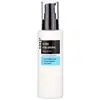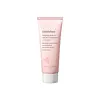What's inside
What's inside
 Key Ingredients
Key Ingredients

 Benefits
Benefits

 Concerns
Concerns

 Ingredients Side-by-side
Ingredients Side-by-side

Water
Skin ConditioningButylene Glycol
HumectantCaprylic/Capric Triglyceride
MaskingGlycerin
HumectantGlyceryl Acrylate/Acrylic Acid Copolymer
HumectantPropylene Glycol
HumectantPvm/Ma Copolymer
Emulsion StabilisingCetyl Ethylhexanoate
EmollientSodium Hyaluronate
HumectantHydrolyzed Jojoba Esters
Skin ConditioningJojoba Esters
Emollient1,2-Hexanediol
Skin ConditioningArachidyl Alcohol
EmollientBehenyl Alcohol
EmollientArachidyl Glucoside
EmulsifyingCyclomethicone
EmollientPolysorbate 60
EmulsifyingGlyceryl Stearate
EmollientPEG-100 Stearate
Dimethicone
EmollientHydrogenated Lecithin
EmulsifyingSorbitan Stearate
EmulsifyingAllantoin
Skin ConditioningXanthan Gum
EmulsifyingCarbomer
Emulsion StabilisingDisodium EDTA
Tocopheryl Acetate
AntioxidantArginine
MaskingAloe Barbadensis Leaf Extract
EmollientLilium Tigrinum Extract
Skin ConditioningCucurbita Pepo Fruit Extract
Skin ConditioningThymus Vulgaris Extract
PerfumingPsidium Guajava Fruit Extract
AstringentMalpighia Emarginata Fruit Extract
Skin ConditioningHydrolyzed Collagen
EmollientPortulaca Oleracea Extract
Skin ConditioningSnail Secretion Filtrate
Skin ConditioningLeontopodium Alpinum Extract
Skin ConditioningMalva Sylvestris Flower Extract
Skin ConditioningBuddleja Davidii Extract
Skin ConditioningAloe Vera Callus Extract
AntioxidantCamellia Sinensis Callus Culture Extract
PerfumingChrysanthemum Indicum Callus Culture Extract
AntioxidantBambusa Vulgaris Callus Culture Extract
Skin ConditioningEthylhexylglycerin
Skin ConditioningParfum
MaskingWater, Butylene Glycol, Caprylic/Capric Triglyceride, Glycerin, Glyceryl Acrylate/Acrylic Acid Copolymer, Propylene Glycol, Pvm/Ma Copolymer, Cetyl Ethylhexanoate, Sodium Hyaluronate, Hydrolyzed Jojoba Esters, Jojoba Esters, 1,2-Hexanediol, Arachidyl Alcohol, Behenyl Alcohol, Arachidyl Glucoside, Cyclomethicone, Polysorbate 60, Glyceryl Stearate, PEG-100 Stearate, Dimethicone, Hydrogenated Lecithin, Sorbitan Stearate, Allantoin, Xanthan Gum, Carbomer, Disodium EDTA, Tocopheryl Acetate, Arginine, Aloe Barbadensis Leaf Extract, Lilium Tigrinum Extract, Cucurbita Pepo Fruit Extract, Thymus Vulgaris Extract, Psidium Guajava Fruit Extract, Malpighia Emarginata Fruit Extract, Hydrolyzed Collagen, Portulaca Oleracea Extract, Snail Secretion Filtrate, Leontopodium Alpinum Extract, Malva Sylvestris Flower Extract, Buddleja Davidii Extract, Aloe Vera Callus Extract, Camellia Sinensis Callus Culture Extract, Chrysanthemum Indicum Callus Culture Extract, Bambusa Vulgaris Callus Culture Extract, Ethylhexylglycerin, Parfum
Water
Skin ConditioningPropanediol
SolventNiacinamide
SmoothingGlycerin
HumectantBetaine
Humectant1,2-Hexanediol
Skin ConditioningPPG-13-Decyltetradeceth-24
EmulsifyingCaprylic/Capric Triglyceride
MaskingOctyldodeceth-16
EmulsifyingGlyceryl Caprylate
EmollientDisodium EDTA
Ethylhexylglycerin
Skin ConditioningParfum
MaskingPrunus Yedoensis Leaf Extract
Skin ConditioningTocopherol
Antioxidant
 Reviews
Reviews

Ingredients Explained
These ingredients are found in both products.
Ingredients higher up in an ingredient list are typically present in a larger amount.
1,2-Hexanediol is a synthetic liquid and another multi-functional powerhouse.
It is a:
- Humectant, drawing moisture into the skin
- Emollient, helping to soften skin
- Solvent, dispersing and stabilizing formulas
- Preservative booster, enhancing the antimicrobial activity of other preservatives
This ingredient is an emollient, solvent, and texture enhancer. It is considered a skin-softener by helping the skin prevent moisture loss.
It helps thicken a product's formula and makes it easier to spread by dissolving clumping compounds.
Caprylic Triglyceride is made by combining glycerin with coconut oil, forming a clear liquid.
While there is an assumption Caprylic Triglyceride can clog pores due to it being derived from coconut oil, there is no research supporting this.
Learn more about Caprylic/Capric TriglycerideDisodium EDTA plays a role in making products more stable by aiding other preservatives.
It is a chelating agent, meaning it neutralizes metal ions that may be found in a product.
Disodium EDTA is a salt of edetic acid and is found to be safe in cosmetic ingredients.
Learn more about Disodium EDTAEthylhexylglycerin (we can't pronounce this either) is commonly used as a preservative and skin softener. It is derived from glyceryl.
You might see Ethylhexylglycerin often paired with other preservatives such as phenoxyethanol. Ethylhexylglycerin has been found to increase the effectiveness of these other preservatives.
Glycerin is already naturally found in your skin. It helps moisturize and protect your skin.
A study from 2016 found glycerin to be more effective as a humectant than AHAs and hyaluronic acid.
As a humectant, it helps the skin stay hydrated by pulling moisture to your skin. The low molecular weight of glycerin allows it to pull moisture into the deeper layers of your skin.
Hydrated skin improves your skin barrier; Your skin barrier helps protect against irritants and bacteria.
Glycerin has also been found to have antimicrobial and antiviral properties. Due to these properties, glycerin is often used in wound and burn treatments.
In cosmetics, glycerin is usually derived from plants such as soybean or palm. However, it can also be sourced from animals, such as tallow or animal fat.
This ingredient is organic, colorless, odorless, and non-toxic.
Glycerin is the name for this ingredient in American English. British English uses Glycerol/Glycerine.
Learn more about GlycerinParfum is a catch-all term for an ingredient or more that is used to give a scent to products.
Also called "fragrance", this ingredient can be a blend of hundreds of chemicals or plant oils. This means every product with "fragrance" or "parfum" in the ingredients list is a different mixture.
For instance, Habanolide is a proprietary trade name for a specific aroma chemical. When used as a fragrance ingredient in cosmetics, most aroma chemicals fall under the broad labeling category of “FRAGRANCE” or “PARFUM” according to EU and US regulations.
The term 'parfum' or 'fragrance' is not regulated in many countries. In many cases, it is up to the brand to define this term.
For instance, many brands choose to label themselves as "fragrance-free" because they are not using synthetic fragrances. However, their products may still contain ingredients such as essential oils that are considered a fragrance by INCI standards.
One example is Calendula flower extract. Calendula is an essential oil that still imparts a scent or 'fragrance'.
Depending on the blend, the ingredients in the mixture can cause allergies and sensitivities on the skin. Some ingredients that are known EU allergens include linalool and citronellol.
Parfum can also be used to mask or cover an unpleasant scent.
The bottom line is: not all fragrances/parfum/ingredients are created equally. If you are worried about fragrances, we recommend taking a closer look at an ingredient. And of course, we always recommend speaking with a professional.
Learn more about ParfumWater. It's the most common cosmetic ingredient of all. You'll usually see it at the top of ingredient lists, meaning that it makes up the largest part of the product.
So why is it so popular? Water most often acts as a solvent - this means that it helps dissolve other ingredients into the formulation.
You'll also recognize water as that liquid we all need to stay alive. If you see this, drink a glass of water. Stay hydrated!
Learn more about Water